Authors
Rob York

Rob York is Program Director for Regional Affairs at the Pacific Forum. He is a Ph.D. candidate in Korean history at the University of Hawaii at Manoa, where he also received his master’s degree in Asian studies. Before joining the Pacific Forum, York worked as a production editor at The South China Morning Post and as chief editor of NK News, a specialist site focused on news and analysis of North Korea. York’s research specialties include North Korean diplomacy and leadership politics, as well as East Asian trade and media discourse. He has worked for newspapers in the United States, South Korea and Hong Kong, and earned his bachelor’s degree in communications from Southern Adventist University in Tennessee.
Articles by Rob York

US - Korea
September — December 2023Calm in the Storm
There are many metaphors about using propitious moments to prepare for an inclement future: make hay while the sun shines, the best time to fix the roof is on a clear day, strike while the iron is hot, etc. These all imply the drudgery of work: a farmer baling hay on a sunny day, a slater shingling high on a roof under a blue sky, a forger hammering inside a sweltering workshop on a breezy afternoon. In a third semester continuation of the rest of a tense, yet stable 2023, there is a sense in which both South Korea and North Korea have been following the lesson of these proverbs as they use relative calm on the Korean Peninsula to build out their respective, opposed security and defense capabilities. Another, similar proverb captures an additional element of this dynamic: if you spend your whole life waiting for the storm, you’ll never enjoy the sunshine. Despite the tension on the Korean Peninsula, leaders in both Seoul and Pyongyang appear confident, even buoyant about their security and defense buildups.
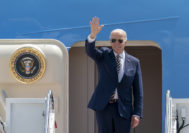
ROUNDTABLE
January 24, 2023Indo-Pacific Policy in the 2nd Half of Biden’s Term
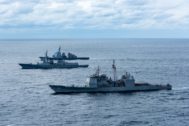
US - Korea
September — December 2022Everything Everywhere All at Once, Extremely Close and Incredibly Loud
Continuing a trend from the May-August reporting period, the final reporting period of 2022 in US-Korea relations was marked by an accelerated ratcheting up of tension. In short, numerous problems reared up on the Korean Peninsula from September-December, and good solutions have been few. And not only does this describe relations between the US and North Korea, but in their own, friendly way also the situation between Washington and Seoul, whose frequent invocations of rock-solid alliance cooperation belie unease about crucial areas of partnership.
Two critical issues have been increasingly affecting the US-South Korea alliance in 2022, with the September-December period no exception. First, South Korea desires ever more alliance-partner defense and security reassurance from the US in the face of a growing North Korean nuclear threat and Chinese revisionism. Yet the US has downward-trending limits on credible reassurance as North Korea masters nuclear weapons technology that threatens US extended nuclear deterrence for South Korea. The US also faces less geopolitical pressure to effusively reassure its Indo-Pacific allies—including South Korea—as China grows to menace the regional order and the US consequently faces lower risk of ally hedging or realignment.

ROUNDTABLE
October 26, 2022China’s Foreign Relations After the Party Congress

US - Korea
May — August 2022Split Images
Lopsided: such was the state of US relations with the two Koreas during May-August 2022. The Washington-Seoul axis mostly flourished on the military/security, diplomatic, economic, and cultural fronts, while Washington and Pyongyang deepened doldrums whose depths had been plumbed in prior reporting periods. For the former, the most significant items included the May inauguration of conservative South Korean President Yoon Suk Yeol and quick follow-on summit with US President Joe Biden, increasing trilateral US-South Korea-Japan cooperation, a raft of announcements on US-South Korea economic and technology cooperation, the resumption of field maneuvers in US-South Korea joint military exercises, and South Korea’s continuing growth as a serious middle power player in foreign policy, including stepped-up engagement with NATO. In US-North Korea relations, a COVID-19 outbreak failed to lead the Kim Jung Un regime to open up to outside humanitarian assistance, as Pyongyang remained content to keep borders mostly closed and allow the virus to course through the population with only basic prophylactic measures. On the positive side, Pyongyang’s hyperactive missile testing in spring slowed during summer, and a feared (yet still expected) seventh nuclear test failed to materialize.
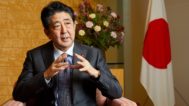

ROUNDTABLE
June 13, 2022Flashpoints in the Indo-Pacific Following the Russian invasion of Ukraine
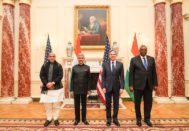
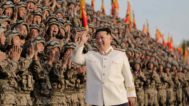
US - Korea
January — April 2022When It Rains, It Pours
Winter/Spring 2022 was a dynamic, clarifying time in US-Korea relations, following repetitious, turbid reporting periods in 2021. South Korea geared up for and held a presidential election, won with a razor-thin margin by conservative Yoon Suk-yeol. His new administration, replacing the progressive government of term-limited Moon Jae-in, promises to place very different accents on the US-South Korea alliance and inter-Korean relations. Washington is relieved to see Yoon assume office, as US senior leadership, policymakers, and alliance managers are comfortable with his foreign and security/defense policy team. Moon and his progressives did plenty to advance the US-South Korea alliance, but their parochial, Peninsula-focused diplomacy was occasionally a source of friction and often seemingly quixotic vis-à-vis North Korea. The Yoon administration is poised to attempt to make the US-South Korea alliance more comprehensive geographically and functionally, although conservative administrations also pose their own idiosyncratic risks to the US-ROK alliance. For its part, North Korea embarked on an unprecedented missile launch spree during the January-April 2022 reporting period, with 13 separate tests or demonstrations (with three more to follow so far in May) of a variety of known and new systems ranging from short-range ballistic missiles (SRBMs) to hypersonic weapons to (supposedly) the previously untested Hwasong-17 intercontinental ballistic missile (ICBM). Three more missile tests followed in May. North Korean supreme leader Kim Jong Un subtly clarified that Pyongyang’s nuclear posture is not totally deterrence-focused, but includes warfighting use, underscoring the likelihood the regime develops tactical nuclear weapons. This would also likely mean a seventh nuclear test. Pyongyang’s provocations and fiery rhetoric were leavened with celebration, as April parades in North Korea marked the 110th Day of the Sun (the birthday of Kim Il Sung) and the 90th anniversary of the foundation of the Korean People’s Army (KPA). These events have a primarily domestic focus, but they also serve as international propaganda, announcing outwardly that North Korea is strong and united. This attempt at perception management will be tested by reality, as an outbreak of omicron variant COVID-19 in early May represents a serious risk for North Korea.
Looming in the background of these events was the Russia-Ukraine war, which has current and future implications for US relations with the Koreas. South Korea slowly but surely supported US-led sanctions on Russia, while North Korea predictably blamed the US for the conflict. Going forward, Washington’s likely increasing pressure on Moscow will be a litmus test for Seoul’s willingness to work comprehensively with its alliance partner on maintaining the international rules-based order; that same pressure campaign will also open up possibilities for greater Pyongyang-Moscow cooperation, notably in sanctions evasion.

US - Korea
September — December 2021Peninsular Inertia
The final four months of 2021 US-Korea relations played out largely as anticipated: the US deprioritized creative outreach to North Korea and generally subordinated the Korean Peninsula (both South and North) to the US-China rivalry. North Korea was considered likely to continue its self-imposed isolation while advancing its nuclear and missile arsenal. And it was expected that South Korea would doggedly pursue inter-Korean diplomacy while building up its military capabilities, optimizing a calibrated approach to the US and China, and bracing for a period of political opacity leading up to the March 2022 presidential election. Standard set-pieces were also evident during the September-December reporting period: US and South Korean officials did the yeoman’s work of alliance management via frequent meetings and periodic performative statements of alliance cohesion. North Korea celebrated National Foundation Day and the anniversary of the Worker’s Party of Korea, and held an end-of-year party plenum. South Korean President Moon Jae-in used his UN General Assembly speech to encourage international support for inter-Korean reconciliation.
The third trimester of 2021 did have some surprises, however. The Moon administration’s full-court press for a declaration of the end of Korean War was out of step with US and North Korean priorities. Announcement of the AUKUS (Australia-UK-US) strategic pact caught all off-guard, including Seoul, which has jealously eyed Washington’s decision to work with Canberra on a nuclear-propelled attack submarine. US insistence on ensuring that South Korea’s technology industry comports with US geostrategic aims vis-à-vis China was more strongly visible—and friction-inducing—than expected. And Squid Game rocketed from obscurity to global sensation, proving that BTS does not have a monopoly on South Korea’s cultural exports.